We will undertake an unprecedented international effort toward analysing multi-wavelength space-borne observational data from the birth-places of exo-planets, complemented by various ground-based data, their interpretation and comprehensive theoretical modelling. Our ultimate science goal is to understand the observed diversity of discs and exo-planetary systems via detailed measurements and modelling. To reach this challenging goal we have identified five major steps, capitalising on our expertise from observing to modelling.
Objective 1:Multi-wavelength data collection
Our first aim is the collection of coherent multi-wavelength data sets from X-rays to cm wavelengths for carefully selected objects with sufficient data overlap. This includes photometric fluxes, low and high-resolution spectra, line fluxes and profiles, channel maps, interferometric data and images. Our aim is to obtain complete data sets for about 40-50 objects, including:
- X-ray and UV: Xmm, Chandra, Hst/Cos, Hst/Stis, FUSE, IUE
- near-mid IR: Vlt/CRIRES, Vlt/PIONIER, Vlt/MIDI, ISO, SPITZER
- far-IR: Herschel/PACS, Herschel/SPIRE
- (sub)mm: JCMT/HARP & SCUBA-2, IRAM, PdB, APEX, ALMA
- cm: eMerlin, EVLA
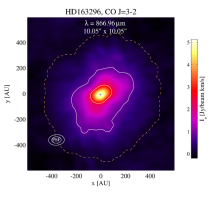
ALMA (public) science verification data
of the Herbig Ae star HD 163296
in CO J = 3 → 2
Note that our data collection will be made public through this webpage at the end of the
project 03/2016!
Objective 2: Consistent gas + dust modelling
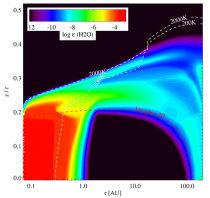
Our second aim is a qualified analysis, consistent interpretation, and unified modelling of these data. We will use the Monte-Carlo radiative transfer programs MCFOST and MCMax, and the radiation thermo-chemical disc program ProDiMo.
Our aim is to simultaneously fit all available observations by unique models for all objects in our target list.
Predicted water concentration in a TTauri model
Note that our model results, e.g. density, temperature, and chemical structures of the discs, will be made public through this webpage at the end of the project 03/2016!
Objective 3: Model calibration
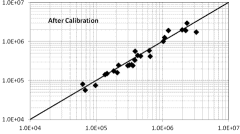
Our third aim is to improve and complete the models based on the feedback from the observations. Compared to the degree of sophistication in observational techniques and the amount of detail revealed by leading observatories, current theory/modelling is clearly lagging far behind.
Many processes (e. g. chemical networks, gas heating & cooling, non-LTE line formation) are only poorly accounted for in the models. This is partly due to gaps in laboratory data, but also due to demanding conceptual and numerical tasks that need manpower. The advantage of our project lies in its multi-wavelength approach, the cutting-edge expertise of the team leaders, and the ability to test our modelling techniques (self-consistently solving for all the available data) against observations.
Objective 4: Conditions for planet formation
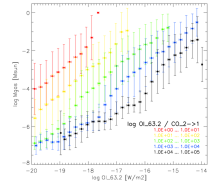
Our fourth aim is a systematic analysis of protoplanetary discs resulting from our calibrated models. We will calculate large model grids that allow identifying systematic trends and statistical correlations between the various observable continuum and line fluxes and the input stellar, disc and dust properties. Based on our models we will predict the disc structure also in the optically thick midplanes, accessible only to radio observations. Thereby we can calculate the various dust and gas properties in the discs as a function of stellar type and age that set the initial conditions for planet formation, leading to a better understanding of how, where and when planets can form.
Diagnostic tool to measure the disc mass based of CO 2-1 and [OI]63mic line fluxes,
from Kamp et al. (2011, A&A 532, A85)
Objective 5: Dissemination of results
Our fifth aim is to communicate our results to the scientific community (for example through this webpage), as well as to a public audience, and to get in touch with external researches who can use our results for their research.
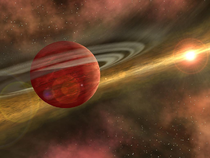
Thus, we are very interested in starting collaborations with scientists who could take our results (densities, temperatures, chemical composition, degree of ionisation, dust properties, heating/cooling rates, etc.) as input for their planet formation and migration theories and scenarios.
Courtesy NASA/JPL-Caltech